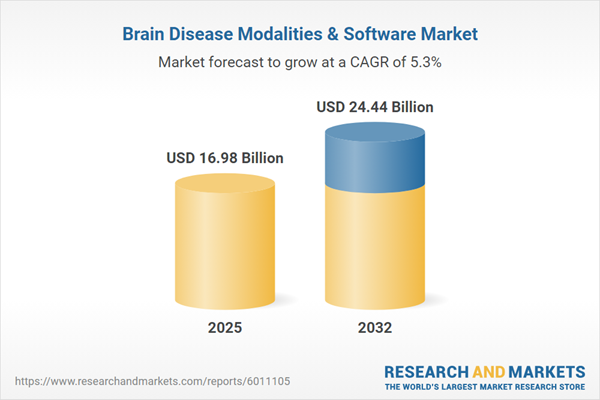Speak directly to the analyst to clarify any post sales queries you may have.
The Brain Disease Modalities & Software Market is evolving rapidly, propelled by clinical demand for early diagnosis and the integration of multimodal imaging and advanced software solutions. Senior leaders and decision-makers are challenged to adapt strategies, align with technological innovation, and respond to shifting global dynamics in order to maximize both patient outcomes and business value.
Market Snapshot: Brain Disease Modalities & Software Market Growth
The global Brain Disease Modalities & Software Market grew from USD 16.11 billion in 2024 to USD 16.98 billion in 2025, and is forecast to expand at a CAGR of 5.34% to reach USD 24.44 billion by 2032. This growth is driven by rising neurological disease burdens, ongoing innovation in imaging technologies, and the increasing deployment of advanced diagnostic software across healthcare systems worldwide. Stakeholders targeting this market benefit from expanding demand solutions supporting early diagnosis, precision therapies, and integrated decision-support platforms enhancing clinical efficiency.
Scope & Segmentation
This report delivers comprehensive analysis across market segments, enabling decision-makers to identify opportunities and assess market readiness for a wide range of products, services, and technologies.
- Imaging Modality: Computed tomography (conventional, spectral); electroencephalography (ambulatory, routine); magnetic resonance imaging (structural, functional, diffusion tensor); magnetoencephalography (resting state, evoked response); positron emission tomography (amyloid PET, FDG PET); ultrasound (high resolution, transcranial Doppler).
- Software Type: AI-based (deep learning, machine learning), clinical decision support, diagnostic (image analysis, segmentation), monitoring (neurophysiological, remote patient), telehealth, workflow management.
- Disease Indication: Alzheimer’s disease, epilepsy (focal onset, generalized onset), multiple sclerosis, Parkinson's disease, stroke (ischemic, hemorrhagic), traumatic brain injury (mild, severe).
- End User: Ambulatory surgical centers, clinics (neurology, rehabilitation), diagnostic imaging centers, hospitals (private, public), research institutes.
- Deployment Mode: Cloud based, hybrid, on premise.
- Distribution Channel: Direct, distributors, online platforms.
- Regions Analyzed: Americas (North America—United States, Canada, Mexico; Latin America—Brazil, Argentina, Chile, Colombia, Peru); Europe, Middle East & Africa (Europe—United Kingdom, Germany, France, Russia, Italy, Spain, Netherlands, Sweden, Poland, Switzerland; Middle East—United Arab Emirates, Saudi Arabia, Qatar, Turkey, Israel; Africa—South Africa, Nigeria, Egypt, Kenya); Asia-Pacific (China, India, Japan, Australia, South Korea, Indonesia, Thailand, Malaysia, Singapore, Taiwan).
- Leading Companies: Siemens Healthineers AG, GE HealthCare Technologies Inc., Koninklijke Philips N.V., Canon Medical Systems Corporation, Hitachi, Ltd., Brainlab AG, Elekta AB (publ), Medtronic plc, Stryker Corporation, IBM Corporation.
Key Takeaways for Senior Decision-Makers
- Emerging modalities and analytics platforms are transforming both workflow efficiency and diagnostic precision, reducing timelines from image capture to actionable insights.
- AI and machine learning are increasingly embedded in clinical routines, automating complex image segmentation and supporting real-time decision-making.
- Integrated cloud-native and edge computing architectures are empowering remote facilities with secure, cost-effective access to advanced analytical resources.
- Healthcare providers and technology vendors are collaborating more often to balance regional regulatory differences, cost pressures, and evolving reimbursement landscapes.
- Adaptive segmentation and flexible deployment options allow organizations to scale solutions and address varying infrastructure capabilities across global markets.
Tariff Impact: Navigating Trade Policy Shifts
Recent United States tariffs have influenced procurement strategies and supply chain configurations, prompting a shift towards local production and the optimization of software for performance on lower-cost hardware. Providers are increasingly aligning with regional cloud partners and seeking diversified sources to sustain market competitiveness and supply continuity.
Methodology & Data Sources
Findings in this report are built on a mixed-methods approach combining in-depth interviews with clinicians, researchers, and software developers, as well as structured surveys of healthcare providers and technology vendors. Data synthesis draws on regulatory filings, clinical trial registries, published research, and expert validation workshops to ensure accuracy and reliability.
Why This Report Matters
- Enables senior leaders to anticipate technology adoption paths and design informed cross-border go-to-market strategies based on actionable segmentation and regional intelligence.
- Identifies critical success factors for investment, partnership, and development—facilitating alignment with evolving regulatory and reimbursement environments globally.
Conclusion
The Brain Disease Modalities & Software Market is shaped by technological advancements, regulatory changes, and evolving care models. Strategic, data-driven insights from this report support senior decision-makers in achieving clinical and operational objectives while maintaining sustainable market growth.
Additional Product Information:
- Purchase of this report includes 1 year online access with quarterly updates.
- This report can be updated on request. Please contact our Customer Experience team using the Ask a Question widget on our website.
Table of Contents
3. Executive Summary
4. Market Overview
7. Cumulative Impact of Artificial Intelligence 2025
Companies Mentioned
The companies profiled in this Brain Disease Modalities & Software market report include:- Siemens Healthineers AG
- GE HealthCare Technologies Inc.
- Koninklijke Philips N.V.
- Canon Medical Systems Corporation
- Hitachi, Ltd.
- Brainlab AG
- Elekta AB (publ)
- Medtronic plc
- Stryker Corporation
- IBM Corporation
Table Information
| Report Attribute | Details |
|---|---|
| No. of Pages | 199 |
| Published | October 2025 |
| Forecast Period | 2025 - 2032 |
| Estimated Market Value ( USD | $ 16.98 Billion |
| Forecasted Market Value ( USD | $ 24.44 Billion |
| Compound Annual Growth Rate | 5.3% |
| Regions Covered | Global |
| No. of Companies Mentioned | 11 |









